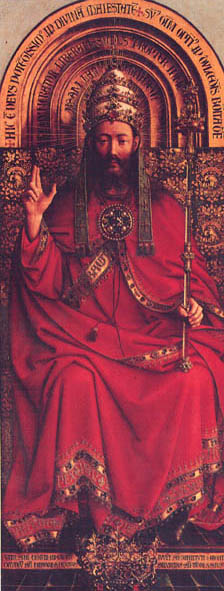Image Details

Scala/Art Resource
Kings of Kings, Jan and Hubert Van Eyck (1432). The King of Kings is the dominant figure on a triptych, or three-paneled screen behind and above the great altarpiece at the cathedral in Ghent, Belgium.
Two levels of paintings appear on the three-paneled screen. The lower zone shows a continuous landscape peopled with numerous small figures worshipping at an altar and fountain of life. The entire upper zone is rendered in a different scale; gigantic figures contrast with the multitude of worshippers below. The central figure of the upper zone, the King of Kings shown here, is flanked by Adam and Eve, music-making angels, Mary and St. John the Baptist.
The mature but young man robed in royal red looks out toward us, but with an unfocused gaze that makes no contact with us as individuals. The absolute frontality of the face, with features that, unlike our own, are entirely symmetrical, gives an otherworldly cast to the face. The Van Eyck brothers’ God, or King of Kings, wears the elaborate jeweled Papal tiara as a reference to spiritual power; the exquisite crown at his feet symbolizes secular power. Around the arch of the niche in which God is enthroned is a Latin inscription, “This is God Most Powerful on account of his divine Majesty. The Most High, the greatest of all because of the goodness of his mildness. The Most Gracious Rewarder because of his immense largesse.” On the cloak of honor behind him, embroidered motifs of the “Pelican in its Piety” evoke Jesus and his sacrifice. The pelican is shown plucking feathers hom its breast so that its blood flows to feed its own young. This motif became a symbol of Jesus’ sacrifice. Thus, this figure is not only God, the first person of the Trinity, but also Christ, the second, and, by implication, the third, the Holy Spirit, as well.
